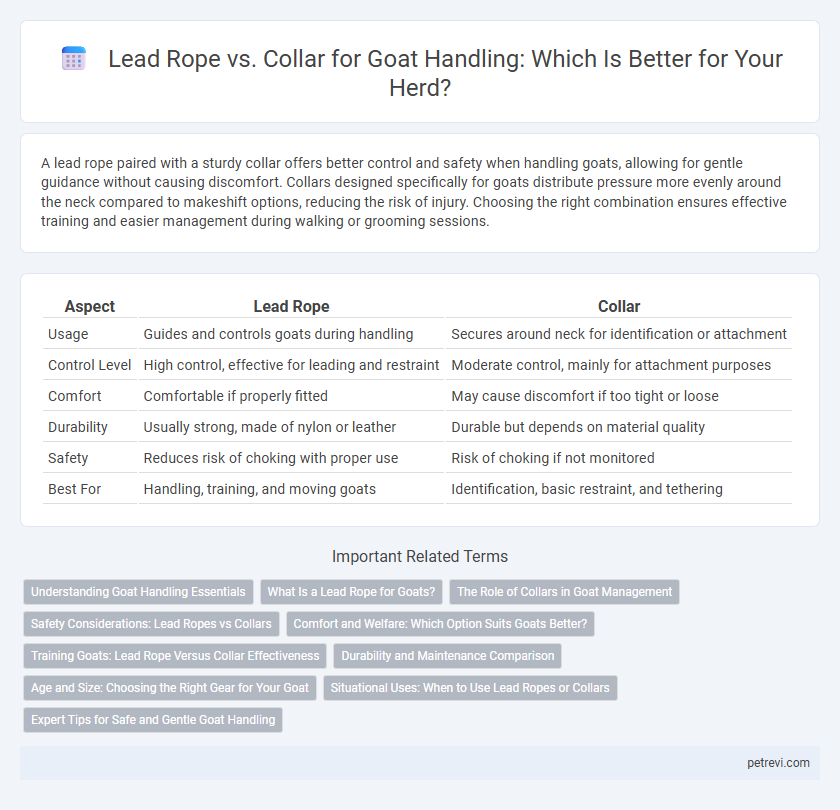A lead rope paired with a sturdy collar offers better control and safety when handling goats, allowing for gentle guidance without causing discomfort. Collars designed specifically for goats distribute pressure more evenly around the neck compared to makeshift options, reducing the risk of injury. Choosing the right combination ensures effective training and easier management during walking or grooming sessions.
Table of Comparison
| Aspect | Lead Rope | Collar |
|---|---|---|
| Usage | Guides and controls goats during handling | Secures around neck for identification or attachment |
| Control Level | High control, effective for leading and restraint | Moderate control, mainly for attachment purposes |
| Comfort | Comfortable if properly fitted | May cause discomfort if too tight or loose |
| Durability | Usually strong, made of nylon or leather | Durable but depends on material quality |
| Safety | Reduces risk of choking with proper use | Risk of choking if not monitored |
| Best For | Handling, training, and moving goats | Identification, basic restraint, and tethering |
Understanding Goat Handling Essentials
A lead rope provides better control and flexibility when handling goats, especially during training or veterinary care, as it attaches directly to a collar or halter, preventing escape and allowing guided movement. Collars, preferably breakaway or adjustable types, ensure comfort and safety, reducing the risk of injury or choking during restraint. Choosing the right combination of lead rope and collar enhances effective goat management by balancing control, animal welfare, and ease of use.
What Is a Lead Rope for Goats?
A lead rope for goats is a sturdy, flexible cord designed to attach to a goat's collar or halter, allowing safe and controlled handling during activities such as walking, training, or veterinary care. Typically made from durable materials like nylon or cotton, lead ropes provide adequate length and grip to guide goats without causing discomfort or injury. Unlike collars alone, lead ropes enhance handler control and improve goat safety during movement or restraint.
The Role of Collars in Goat Management
Collars play a crucial role in goat management by providing a secure and comfortable way to control and identify goats during handling. Unlike lead ropes, collars allow handlers to attach identification tags and tracking devices, ensuring efficient herd monitoring and health management. Properly fitted collars minimize stress and prevent injury, promoting safer handling practices.
Safety Considerations: Lead Ropes vs Collars
Lead ropes provide more control over goats by distributing pressure evenly, reducing the risk of injury during handling or transport. Collars, if improperly fitted or made of weak material, can cause choking or escape hazards, posing significant safety concerns. Choosing the correct size and durable lead rope material enhances handler safety and goat welfare in various situations.
Comfort and Welfare: Which Option Suits Goats Better?
Lead ropes provide more flexibility and comfort for goats by allowing natural head movement and reducing pressure on the neck, which supports better welfare. Collars, particularly if improperly fitted, can cause discomfort and potential injury by restricting airflow and putting strain on sensitive areas. For optimal goat handling, a properly sized lead rope combined with a well-fitted harness often results in improved comfort and overall welfare.
Training Goats: Lead Rope Versus Collar Effectiveness
Lead ropes provide better control and safety during goat training by allowing precise guidance and reducing the risk of neck injury compared to collars, which can cause discomfort or choking. Using a lead rope with a well-fitted halter enables effective communication and easier correction of unwanted behaviors in goats. Training results improve significantly when handlers prioritize equipment that balances control with the goat's comfort, making lead ropes the preferred choice over collars.
Durability and Maintenance Comparison
Lead ropes made from durable materials like nylon or polypropylene resist wear and require minimal maintenance, often only needing occasional cleaning and inspection for frays. Collars, typically crafted from leather or synthetic fabrics, demand more frequent upkeep such as regular cleaning and conditioning to prevent cracking and ensure longevity. While lead ropes generally offer greater durability with less intensive maintenance, collars provide comfort but require consistent care to maintain their effectiveness and lifespan.
Age and Size: Choosing the Right Gear for Your Goat
Selecting the appropriate lead rope or collar for your goat depends heavily on its age and size, with smaller or younger goats benefiting from lightweight, adjustable collars that provide gentle control without discomfort. Larger or adult goats typically require sturdier lead ropes paired with strong, durable collars designed to handle increased strength and prevent escape. Properly matching equipment to the goat's physical characteristics ensures safe handling, reduces stress, and promotes effective training.
Situational Uses: When to Use Lead Ropes or Collars
Lead ropes are ideal for short-term handling and guiding during activities like grooming, veterinary exams, or moving goats between enclosures. Collars provide consistent control and identification, making them suitable for daily wear or situations where a goat needs to be tethered securely. Choosing between a lead rope and collar depends on the goat's behavior, duration of handling, and safety requirements in various farm management scenarios.
Expert Tips for Safe and Gentle Goat Handling
Using a lead rope with a halter is recommended for precise control and reduces stress on the goat compared to a collar, which can cause choking or injury. Experts advise selecting soft, durable materials for the halter and ensuring a proper fit to prevent rubbing or slipping during handling. For gentle and safe goat management, combining a well-fitted halter with a sturdy lead rope allows for effective guidance without compromising the animal's comfort or safety.
Lead rope vs Collar for Goat handling Infographic

 petrevi.com
petrevi.com